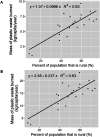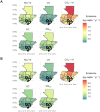Plastic waste generation and emissions from the domestic open burning of plastic waste in Guatemala
- PMID: 36743128
- PMCID: PMC9850929
- DOI: 10.1039/d2ea00082b
Plastic waste generation and emissions from the domestic open burning of plastic waste in Guatemala
Abstract
Domestic, or household-level, open burning of plastic waste is a source of air pollutants and greenhouse gases that are often neglected in emission inventories. Domestic open burning is a considerable concern in Guatemala due to the lack of access to waste collection services, particularly in rural areas. This paper offers the first attempt to estimate emissions from the domestic open burning of waste at the city and departmental levels in Guatemala. Data were collected from the Xalapán region of Jalapa, Guatemala and analyzed to determine the change in plastic waste generation over time as well as the socioeconomic factors that may affect the extent of plastic waste generation and burning. The annual per capita masses of plastic waste burned were used to estimate emissions from domestic open burning of plastic waste in the region of Xalapán, the cities of Jutiapa and Guatemala city, and all 22 departments in Guatemala. Our results show that rural areas burn more waste domestically, likely because of a lack of access to waste collection, and 30.4% of OC, 24.0% of BC, 23.6% of PM2.5, and 2.4% of CO2 emissions in Guatemala may not be accounted for by excluding open plastic burning as a source.
This journal is © The Royal Society of Chemistry.
Conflict of interest statement
There are no conflicts to declare.
Figures




References
-
- Sharma G. Sinha B. Pallavi Hakkim H. Chandra B. P. Kumar A. Sinha V. Gridded Emissions of CO, NOx, SO2, CO2, NH3, HCl, CH4, PM2.5, PM10, BC, and NMVOC from Open Municipal Waste Burning in India. Environ. Sci. Technol. 2019;53(9):4765–4774. doi: 10.1021/acs.est.8b07076. doi: 10.1021/acs.est.8b07076. - DOI - DOI - PubMed
-
- Reyna-Bensusan N. Wilson D. C. Davy P. M. Fuller G. W. Fowler G. D. Smith S. R. Experimental Measurements of Black Carbon Emission Factors to Estimate the Global Impact of Uncontrolled Burning of Waste. Atmos. Environ. 2019;213:629–639. doi: 10.1016/j.atmosenv.2019.06.047. doi: 10.1016/j.atmosenv.2019.06.047. - DOI - DOI
-
- Kaza S., Yao L., Bhada-Tata P. and Van Woerden F., What a Waste 2.0: A Global Snapshot of Solid Waste Management to 2050, The World Bank, 2018, 10.1596/978-1-4648-1329-0 - DOI
Grants and funding
LinkOut - more resources
Full Text Sources
